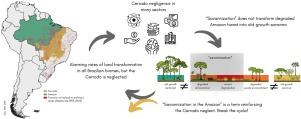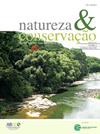“Savannization of the Amazon” is a term that reinforces the Cerrado neglect
IF 3.5
2区 环境科学与生态学
Q1 BIODIVERSITY CONSERVATION
引用次数: 0
Abstract
Words and terms evoke responses in us, independently of their original meaning. Precise language matters because terminology can affect conservation. For example, current deforestation rates put the Amazon in the spotlight of global conservation, particularly after the “savannization of the Amazon” was proposed. This term associates cleared or degraded forests with savannas, reinforcing prejudices against natural savannas. The Cerrado is the world’s largest and richest savanna, but receives less conservation attention and resources. Firstly, we showed a multisector Cerrado neglect: number of protected areas, non-governmental organizations, academic human resources, and companies were larger in the Amazon, but deforested area was proportionally smaller. Secondly, we analyzed the academic use of “savannization of the Amazon.” In all 481 studies using this term, human action was implied, and most meant that degraded Amazon does not become old-growth savanna. We propose abandoning the use of “savannization of the Amazon”, promoting the support and attention the Cerrado needs.

"亚马逊草原化 "一词强化了对 Cerrado 的忽视
词语和术语会唤起我们的反应,而与其原始含义无关。准确的语言很重要,因为术语会影响保护工作。例如,当前的森林砍伐率使亚马逊成为全球保护的焦点,特别是在 "亚马逊热带草原化 "被提出之后。这一术语将开垦或退化的森林与热带稀树草原联系在一起,加深了人们对天然热带稀树草原的偏见。塞拉多(Cerrado)是世界上面积最大、资源最丰富的热带稀树草原,但其受到的保护关注和资源却较少。首先,我们展示了多部门对瑟拉多的忽视:保护区、非政府组织、学术人力资源和公司的数量在亚马逊地区较多,但毁林面积却成比例地较小。其次,我们分析了学术界对 "亚马逊热带草原化 "的使用。在所有 481 项使用该术语的研究中,都暗示了人类的行为,大多数研究的意思是退化的亚马逊不会变成古老的热带稀树草原。我们建议放弃使用 "亚马逊热带稀树草原化",促进对 Cerrado 的支持和关注。
本文章由计算机程序翻译,如有差异,请以英文原文为准。
求助全文
约1分钟内获得全文
求助全文
来源期刊

Perspectives in Ecology and Conservation
Environmental Science-Nature and Landscape Conservation
CiteScore
7.80
自引率
4.30%
发文量
46
审稿时长
59 days
期刊介绍:
Perspectives in Ecology and Conservation (PECON) is a scientific journal devoted to improving theoretical and conceptual aspects of conservation science. It has the main purpose of communicating new research and advances to different actors of society, including researchers, conservationists, practitioners, and policymakers. Perspectives in Ecology and Conservation publishes original papers on biodiversity conservation and restoration, on the main drivers affecting native ecosystems, and on nature’s benefits to people and human wellbeing. This scope includes studies on biodiversity patterns, the effects of habitat loss, fragmentation, biological invasion and climate change on biodiversity, conservation genetics, spatial conservation planning, ecosystem management, ecosystem services, sustainability and resilience of socio-ecological systems, conservation policy, among others.
 求助内容:
求助内容: 应助结果提醒方式:
应助结果提醒方式:


